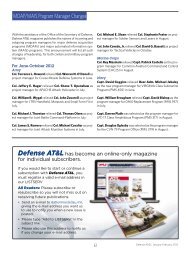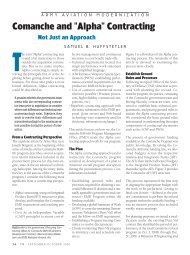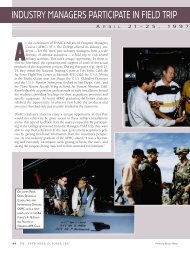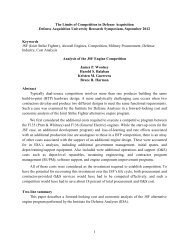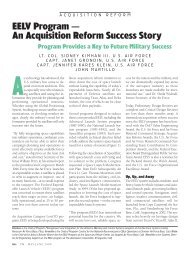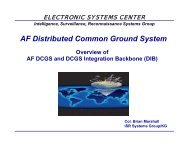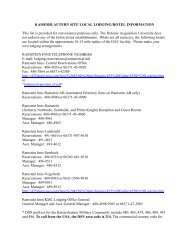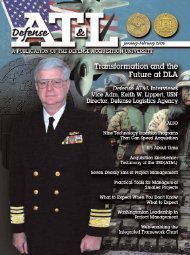Defense ARJ - Defense Acquisition University
Defense ARJ - Defense Acquisition University
Defense ARJ - Defense Acquisition University
You also want an ePaper? Increase the reach of your titles
YUMPU automatically turns print PDFs into web optimized ePapers that Google loves.
systeM DoD WeaPon of systeMs DeVeloPMent<br />
ProGraMs<br />
weapon systems acquisition by cost, schedule, and performance. These acquisition<br />
programs are unpredictable and unstable. Ongoing reviews for acquisition improvements<br />
are being conducted both within and outside DoD to enforce these acquisitions,<br />
resulting in better outcomes for the taxpayer and more responsive support<br />
to the joint warfighter in the 21st century. The major problems addressed by GAO<br />
reports are summarized below.<br />
First, the United States has the world’s best weapon systems, unrivaled in superiority.<br />
The process to deploy these systems needs to be fixed. In today’s acquisition<br />
environment, 40 percent cost increases are common, which add up to tens of millions<br />
of dollars, schedule delays that add up to years, and rebaselining of some large<br />
and expensive programs; indeed, some programs are even scrapped. Consequently,<br />
reduced quantities and capabilities are delivered to the warfighter.<br />
For the past 35 years GAO has documented these problems. Since DoD will be<br />
spending more than $1.4 trillion dollars for new weapon systems between 2005 and<br />
2009, quality and time are essential to maintain weapons superiority, quickly counter<br />
threats from the nation’s adversaries, and better protect and enable the warfighter.<br />
Also, using constant 2006 dollars, the top five programs in 2001 cost $290.8 billion<br />
while the top five programs in 2006 totaled $550 billion. Considering this staggering,<br />
increased dollar spending for weapon systems, the nation will be faced with taking<br />
funds from other federal programs to fund these systems or to reduce funding for<br />
these systems.<br />
Second, DoD does not separate long-term needs from wants. DoD starts many programs<br />
that it cannot afford. Each Service competes for funding creating a Service-centric<br />
structure and fragmented decision-making approach. It does not prioritize programs<br />
based on customer needs and DoD’s long-term vision. Many times when a program<br />
needs funds because of cost increases or schedule delays, funds are taken away from<br />
other programs. This rewards poor performing programs (GAO, March 2007).<br />
An integrated portfolio management investment strategy, as used successfully in<br />
the commercial world, would achieve more executable programs and ensure better<br />
return on investments. More importantly, warfighters would receive greater quantities<br />
and capabilities as promised to them. An investment strategy would prioritize the<br />
order of needed capabilities and match them up against resources—dollars, technologies,<br />
time, and people required to obtain these capabilities as well as define incremental<br />
product development programs for obtaining these capabilities and establish<br />
controls so the requirements, funding, and acquisition processes would work together.<br />
Without an integrated investment strategy, all other improvements will fail as shown<br />
in the past (GAO, March 2007).<br />
Third, in 2003 DoD adopted the defense life cycle management system. This is<br />
a knowledge-based, evolutionary product development approach. GAO examined<br />
programs that began after this system started. DoD is not following it. Early decision<br />
points in the system are frequently bypassed, resulting in decision makers committing<br />
programs to premature system demonstration and initial manufacturing in the face of<br />
significant unknowns about technology, design, and production.<br />
Critical points such as Milestones A and B, the Design Readiness Review, and<br />
Milestone C are not followed at all or only partially. Programs start system develop-<br />
201



